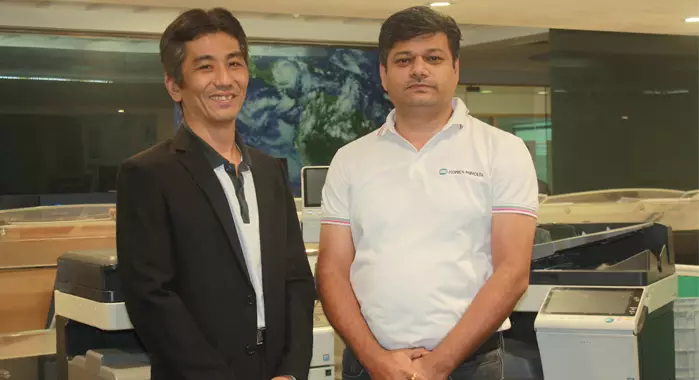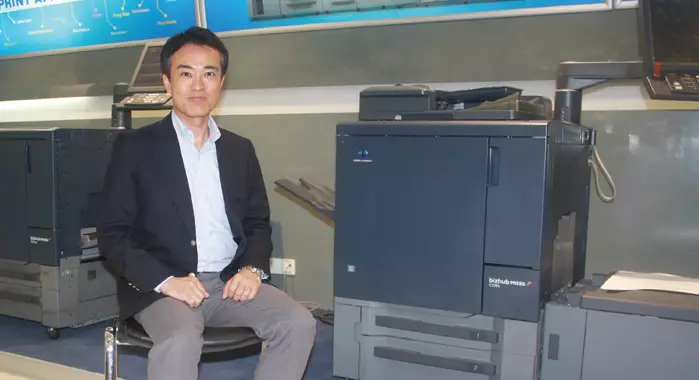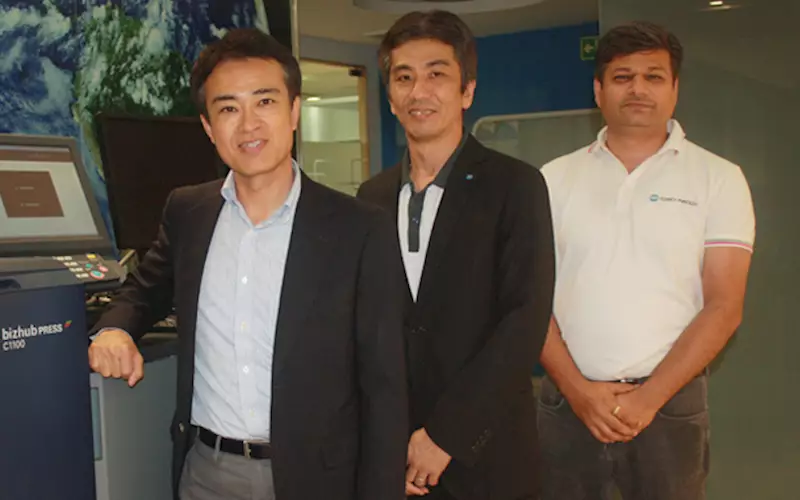RR: What about the temperature reduction on these machines? Is it good for printing?
MG: The reduction in temperature has improved the media flexibility wherein some of the substrates which are plastic-based or vinyl-based can now be processed using digital technology. It adds to more options for our customers. Lesser temperature also means lesser use of electricity.
RR: After capturing a majority of the market in the entry level and low-end segment, Konica Minolta focussed on the mid-market and replicated the selling model with the Bizhub Press C8000 and C1085. I recall the Bizhub Press C8000 was a big hit because it had a metal chassis which could withstand the duty cycle ... While the Bizhub Press C1085 which came as an upgrade of the Bizhub Press C8000 is a very dependable workhorse ... Why did the further upgraded Bizhub Press C1100 not encounter the same success? Was it because of a compromise on some of the parameters?
YK: We don’t see Bizhub Press C1100 as unsuccessful and have sold a fairly good number of machines in India. Bizhub Press C8000 is the first generation machine with metal chassis. Its upgrade Bizhub Press C1085 and then C1100 belong to the same family of machines. Both of them had metal chassis. The difference between the two, apart from the speed, is the change in fusing method. Bizhub Press C8000 was utilising dual fuser. After the feedback from our customers and some R&D at our end we changed the dual fuser to single fuser. This led to an increase in the speed and productivity. In terms of applications both Bizhub Press C1085 with 85ppm speed and C1100 with 100ppm speed are the same.
RR: Initially, the high volume market in India shifted to Bizhub Press C1100 for its lowest cost click. Was this a case of clever pricing? Or smart selling?
MG: We approached our customers with the view of making the business viable with Bizhub Press C1100 and chalked out the model of return on investment without any ambiguity. I think that was our basic strategy. We tried to understand the processes of our customers and made an assessment of the volume of printed jobs that could be shifted to Bizhub Press C1100. The customer could continue to print the large runs on offset whereas the short runs could be shifted to digital. Apart from that we also suggested the kind of applications that can be added to the existing runs thus enabling our customer to provide more value to his customer as well as find new customers for the digital printing jobs.
RR: Konica Minolta penetrated the photo segment with great success. What is the market feedback from the photo album segment for Bizhub Press C70hc series? Has it worked as well as the Bizhub Press C71hc? Also, if you could tell us about the high-chroma series in terms of what it does and its capabilities…
MG: High-chroma, as the name suggests, increases the chromatic range of the toners. This means an extended gamut that is closer to sRGB than that of conventional CMYK toners. The cyan and magenta toners are similar to light cyan and light magenta and that increases the CMYK gamut. Colours can be printed virtually as they are displayed for example on a calibrated monitor. The printing process continues to remain CMYK but the results will be close to sRGB. Photo printing is one of the applications that utilises traditional sRGB process and this had been identified by us when we had begun our operations in India. In terms of the series of machines, Bizhub Press C71hc is an improvement over C70hc with new toner and improved productivity on the engine as well as the improved processing capabilities. The feel of toner and the height of lamination visible on the printed photos have reduced in Bizhub Press C71hc.
RR: What would be the number in terms of the machines sold for both Bizhub Press C70hc and C71hc?
MG: We have stopped the sale and production of Bizhub Press C70hc. Regarding Bizhub Press C71hc, we have sold around 125 devices in 2016 and it continues to remain our most acceptable machine.
RR: Bizhub C71cf is a replica of the C71hc, except that the label press is fitted with a winder re-winder at each end. In terms of cost, there’s a huge difference, almost five times. Given the fact that it’s an entry level kit, do you think that kind of pricing the Bizhub Press C71cf can have the same success that Bizhub Press C71hc has received?
MG: Bizhub Press C71cf still uses electrophotography. We have tied up with Miyakoshi which is a known name in the industry for providing accessories and parts of the machine that can be integrated into the machine. In terms of pricing, instead of the capital cost we are working on the ROI (return on investment) concept wherein the customers are able to make money on per square inch of labels. We compute in terms of the running metre lengths which is how the label industry also calculates.
RR: Why has it been handed over to Insight Communications for the East and West India markets?
YK: Labels is a new segment for both Insight Communications and for us. Insight Communications has partnered with Screen for high volume printing and was looking for someone in the short run segment. This is where Bizhub Press C71cf comes into the picture as an entry level label press. It completes Insight Communications’ portfolio of entry level to high-end machines.

Koide (l) and Gupta
RR: Accurio Jet KM-1 made a splash at Drupa 2016. My colleagues have shown me the print samples. How do you rate the samples in comparison to the FujiFilm 720 and Landa which have Samba inkjet heads from Fujifilm?
MG: On the technology front, except for the fact that Komori is the co-developer of Accurio Jet KM-1, majority of the technology process including the inkjet print heads are manufactured in-house by Konica Minolta. The device incorporates a first of its kind patented UV ink that remains in a semi liquid state before the printing process. This gets converted to liquid state and then gets transferred during the printing process. It allows immediate curing and greater post-press durability. This is the additional benefit as compared to Fujifilm 720 and Landa. The choice of substrates and media capability is higher in Accurio Jet KM-1.
RR: What is the future go-to-market philosophy of Konica Minolta vis-a-vis click charges? How low is low?
YK: So far we have been catering to the customer’s demands in terms of click charges and it has been consistently reducing. It has to stop someday as we cannot keep it reducing forever. Unless, the new GST regime makes some difference. Currently, we are unaware of how it changes anything and whether the cost of print will increase or decrease. It could also be that the introduction of new technology will bring about a change in the use of type of materials and that could lead to a change in costs by further reducing it. But with the current technology and the current machine, I don’t see the cost going down any further.
RR: What is the present status of the Konica Minolta channel partners and who is handling which product in which territory? Moreover what value will each channel partner bring to the table?
DM: We have three partners for the production printing business in India and all the partners have their strengths. TechNova Imaging Systems as a channel partner functions at a pan India level for graphic arts product and is very good at selling to commercial printers. It is more aware of the strengths and the functioning of its customers due to greater accessibility and these very customers are the future users of digital technology. KMI Business Technologies has its forte in the print shop segment and HCL Infosystems is a big giant with government print shops.
YK: We choose to partner with those companies that are able to provide a uniqueness to address various customer segments and help us reach out to as many customers as possible. Konica Minolta doesn’t have much access to the label industry and hence Insight Communications is our channel partner for East and West India markets for the label segment since they are already handling equipment related to label industry and is equally eager to gain a foothold in the label segment which is new for them.
RR: What’s the update on MGI?
YK: We are pretty satisfied with the number of MGI equipment that we have sold. In the last financial year, we sold five MGI devices which are more than our competitor in the country. MGI is even capable of doing spot-foiling digitally which is an added advantage. The capex for MGI is higher because of its capabilities, experience and hence the reluctance that it encounters in the offset space. The digital photo segment has completely accepted the machine since every page and document is a variable which is not the case with offset. In offset space, the digital machines also compete with the traditional offset-like processes and it is in a way a similar challenge as what we have for offset vs digital.
RR: Konica Minolta and EFI? What is status about the hardware and software integration? Is the partnership on / off?
DM: EFI is one of the most trusted partners of Konica Minolta and together we enjoy a healthy relationship. The customer’s requirement will define which platform gets integrated into the machine. It’s a choice that is given to the customer whether to opt for the Konica Minolta platform or if he has had experience with the EFI Fiery platform he could opt for it. Now the customer will even have the choice to opt for Creo platform from Kodak.
RR: What are your expectations in the next 12 months from the Indian market?
DM: We have had significant growth since foundation of the company in 6 years ago and we are planning the same double digit growth for this year as well. That is a bare minimum. Other than that, with regards to Konica Minolta as a group, we are now more focussed towards workflow solutions as well and don’t just want to remain the hardware provider.
YK: Besides new hardware, we are also introducing the complete workflow software. We have tied up with an Ahmedabad- based firm for providing web-to-print solutions to our customers. We are also coming up with cloud-based colour management solution which is called Accurio Cloud Eye through which the customer will be able to simulate same colour at multiple devices and print sites. Then there is job management software that we will come up with and Management Information System (MIS) for shopfloor management.
RR: Final question. How do you unwind? What do you do when you are not working?
DM: I like to travel across the globe. I would love to visit places in India like Shimla and Darjeeling. I also watch a lot of films. The Indian films that I have seen are 3 Idiots and Bahubaali, but I admire the Japanese master Hayao Miyazaki and have seen all of his animation films.













 See All
See All